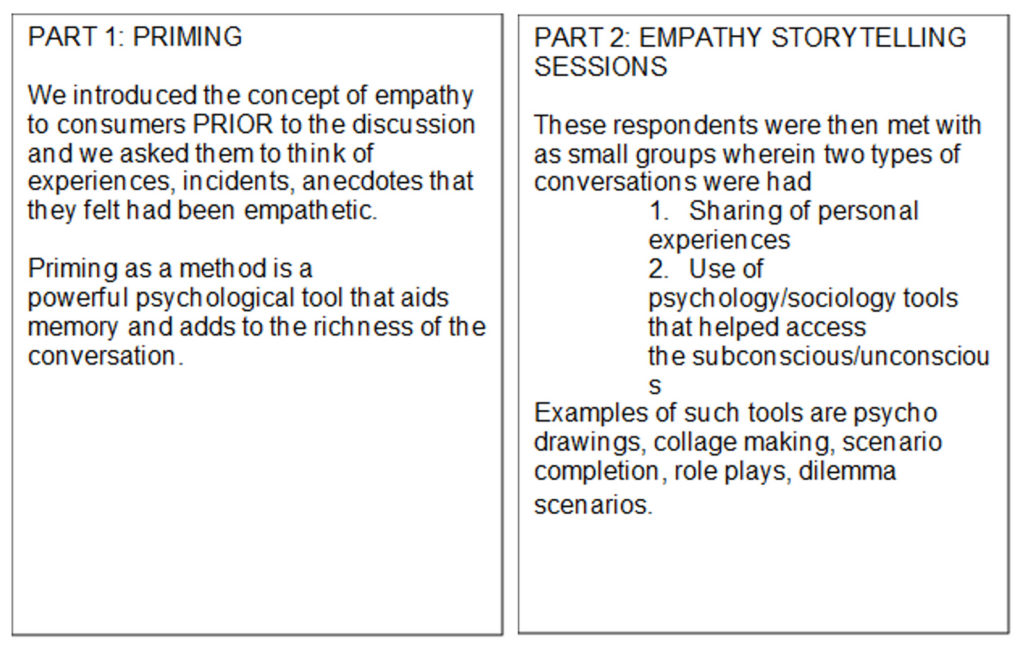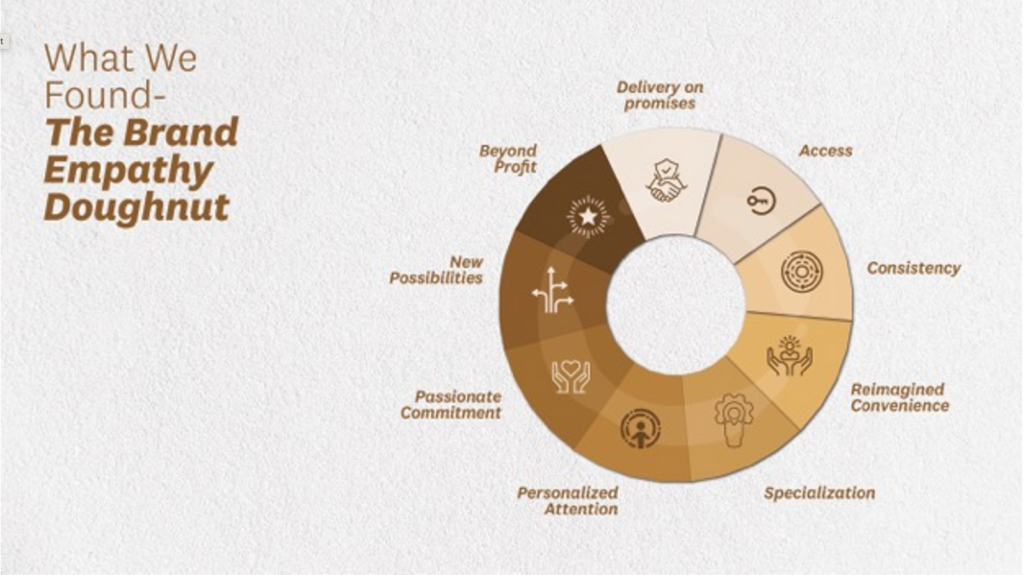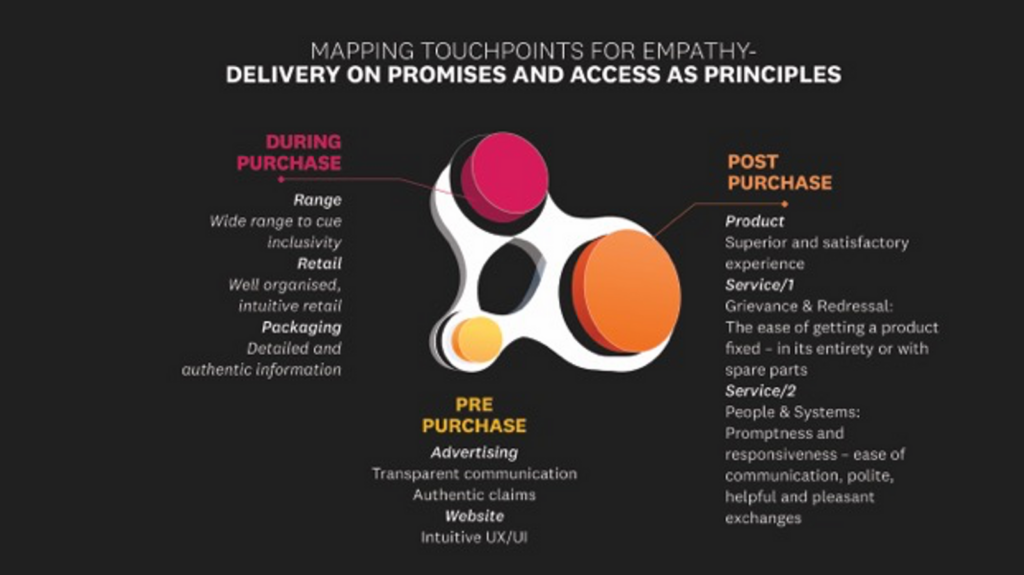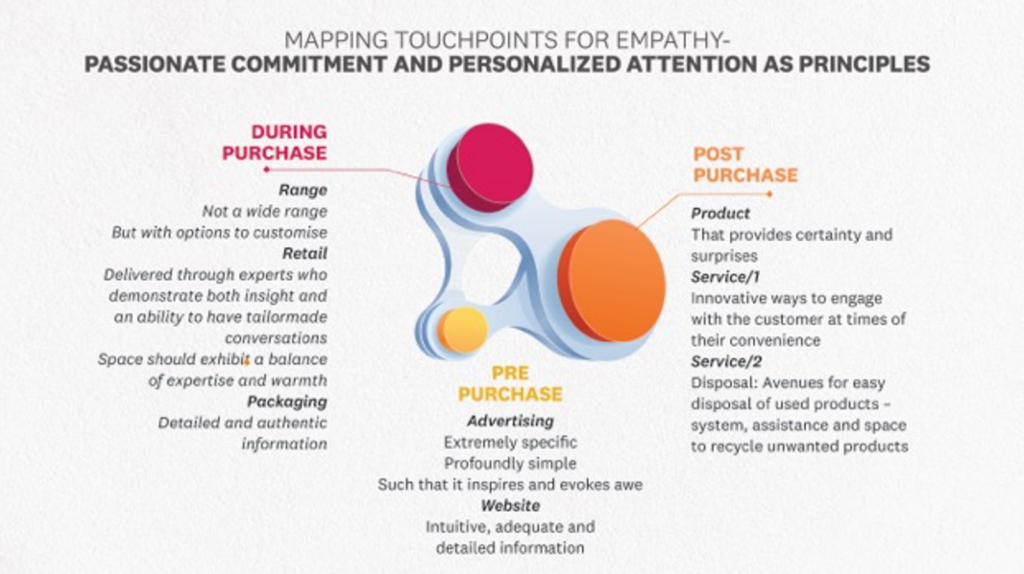In a world where consumers say that they wouldn’t care if 74% of the brands they use disappear and feel that less than 27% of brands improve their lives and well-being, the need to bond more closely with consumers is becoming more urgent.
For consumers, there’s a need to address a feeling of alienation and being ‘used’ by brands for mere profiteering. Increasing isolation and loneliness are perpetuating a vicious cycle of poorer mental health and depression
Even for brands, the need to devise a better way of attracting and retaining consumers is increasing.
There’s evidence of decreasing profitability for brands that don’t create deeper connections with their consumers and a mistrust and suspicion between value chain partners, e.g., retailers/distributors, that risks increasing the cost of doing business.
We believe the answer lies in looking at the relationship between humans and brands with new eyes. We believe that the answer lies in Empathy.
However, what empathy means in developing markets like India or whether it is even relevant to marketing was unclear to us. So, we set out to create a contemporary, clear, and common definition of Empathy. Further, we also understood how such a concept might fit brands.
Our study wasn’t focused on a particular brand or category. It aimed to understand the meaning and manifestation of empathy in a developing culture and whether it was an idea brands could explore.
To decode and define Empathy, we undertook experimental anthropological research. The idea was to map, measure and identify consumer experiences of empathy to evolve alternative sets of ways to discern the experiences of empathy.
The idea wasn’t to have a complex and rigidly structured conversation with consumers about the academic concept of empathy.
We did this through three modes: A) Digital Ethnography and Social Listening, B) Empathy Storytelling Sessions, and C) Expert Interviews.
A. Digital Ethnography and Social Listening
exercises to conduct a preliminary analysis using secondary data available online to nuance our understanding of consumers’ perceptions of empathy and brands.
Given the ever-increasing volume of consumers online, we could mine and analyse publicly available social media feeds (platforms such as Facebook, Instagram, Twitter, etc.), video blogs, articles around the topic and especially pertaining to brands such as: Conversations and chatter about and relating to empathy – stories, incidents, their setting and contexts, associated markers, and empathy cues
- Consumer reviews, preferences, and pain points relating to brands
- Videos that had gone viral given the empathy quotient
B. Empathy storytelling sessions
Mini-Focus Group discussions with Religious Minorities, members of the LGBTQIA+ community, and Prosumers in addition to mainstream consumers (age 18-45) across the various regions of India.
These sessions were in two parts:

Key information areas
- Understand the definition of empathy
- Narratives in popular culture/mythology folklore
- Gather personal experiences of empathy (receiving and giving)
- Explore and interpret the consumers’ conscious and subconscious experiences of empathy from brands across various levels and the expressions, gestures, and feelings associated (before, after and during) with these moments to arrive at ideas surrounding empathy
- Micro-Macro Spectrum – the design pros and cons, anxieties addressed (high priority vs low priority), purpose/cause taken up
- Deep Empathy-Apathy Spectrum – identify what does and does not count as empathy, why/why not
- Understand the consumers’ perceptions of various brands mentioned – products and services – their perceived strengths and shortcomings
- Decipher the tangible attributes and markers of the experience and the context in which it was received.
The purpose of this component was to identify potential codes from consumers’ experiences of empathy and, with the help of experts, arrive at principles that help design brands around the notion of empathy.
C. Expert interviews
We interviewed expert practitioners like Animal Care Experts, Hospitality Experts and Product Designers Counsellors and Marketers, to get a deeper understanding of the experiences of empathy from various experts and to obtain data on recognising and addressing consumer needs and ascertain the identifying principles of empathy (for brands).
Key information areas:
- Explore and interpret the expert mindset across the Deep Empathy-Apathy Spectrum – identity what does and does not count as empathy, why/why not and the expressions, gestures, and feelings associated (before, after and during) with these moments
- Understand how experts recognise and interpret the need for empathy
- Expert PoV on differences between service and product brands on empathy
- Perceived future of empathy
- Trends in the space
- Empathy guardrails for brands
The combination of these three key components helped us triangulate a nuanced interpretation of Empathy. Further, the use of key sociological and psychological techniques were used to facilitate the creation of actionable insights that brands could deploy on their journey to greater Empathy.
At the end of our study, we arrived at a new and emergent definition of Empathy. It is now defined as: “an exchange that recognises and embraces multiple, different realities and creates customised, humanised, non-hierarchical connections. It is a two-way, multi-sensorial exchange of emotional vulnerability that creates deep human connections.”
However, this still begs the question – can businesses, or all brands that represent the various businesses, be empathetic?
Our research indicates that consumers do perceive empathy by businesses if they truly solve a problem or fulfil a need effectively and are happy to obtain this in exchange for payment.
We identified nine principles that can help create more Empathic brand strategies, or what we call the Brand Empathy Doughnut. Each of the dimensions is equally relevant, and brands may choose to demonstrate one or more, but not necessarily all 9. These principles are articulated as follows
- Delivery on Promises: Brands need to ensure they deliver on their functional promises to satisfy the consumer and prevent disappointment.
- Access: Brands should ensure that they incorporate diverse/inclusive ranges, affordable options, and availability at easily accessible outlets to be viewed as empathetic.
- Consistency: Brands must maintain promised quality and deliver on claims over long periods of time/across offerings to create a sense of deep reward for consumers.
- Reimagined convenience: Brands should constantly attempt to make the stressed and pressured lives of consumers easier or hassle-free. This helps consumers feel ‘efficient’ and empowers them to devote time to things that matter to them.
- Specialization: Brands could adopt an approach to developing sharper propositions that cater to specific or unique needs. This results in consumers feeling special and heard.
- Personalized Attention: Paying attention to the individual when needed by being responsive, measured and prompt in service and communication is another way for brands to execute empathy.
- Passionate Commitment: For brands, making an investment in one’s area of focus, striving for authenticity, possessing mastery that delights via superlative experience delivery and a display of ardour towards the subject are decoded as empathy, enabling consumers to also think of themselves as connoisseurs of the category.
- New Possibilities: Devising interventions that create a sense of ‘awe and wonder’ is critical to humans feeling like their lives are being elevated and enriched.
- Beyond profit: Businesses could endeavour to go beyond profit by contributing to the greater good. When a consumer affiliates with brands that truly demonstrate this, she feels proud about doing her bit for society vicariously. The Brand Empathy Doughnut is a sound model for how to refract Empathy across everyday touchpoints. Brands can choose a subset of high impact touchpointsto energise the connection with the brand, to create deep, non-hierarchical human affinity.

If we were to think of the spectrum of touchpoints, the hypothetical example below attempts to take the Empathy dimensions of Delivery on Promises and Access through all the touchpoints:
This could be visually depicted as follows:

However, If we were to imagine these touchpoints through the lens of another set of Empathy dimensions, the delivery of empathy might be significantly different.

Given this, brands should first determine which dimensions of Empathy they want to own and then redesign/design their touchpoints using that dimension.
The contract between brands and consumers needs an urgent renewal. Using a more nuanced and multi-faceted model for Empathy can help transform the way brands think about how they address consumer needs. Only then will consumers build steady bridges between themselves and the marketers who are crafting a more empathic future for the world around them.






